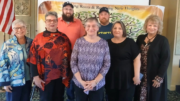SAN FRANCISCO (AP) — A carelessly discarded cigarette, a downed power line, a car’s backfire or a chainsaw’s pull. Just about anything could have started any one of the wildfires now tearing through Northern California, authorities said.
“Every spark is going to ignite a fire,” said Ken Pimlott, the state’s top firefighter. He said the risk remains “extreme for new starts.”
Pimlott said Tuesday that investigators are looking into the causes, but no determination has been made at any of the 17 sites of major wildfires blazing in Northern California.
Pimlott, the California Department of Forestry and Fire Protection director, said “98 percent” of all wildfires are started by people and it’s unlikely lightning is to blame for any of the fires that exploded overnight Sunday, killing at least 17 people so far.
California’s most dangerous wildfire season comes in autumn, when summer heat and insects have left brush dead and dried out, and winds are especially hot, dry and strong.
“This is traditionally California’s worst time for fires,” Pimlott said.
Pimlott said firefighters typically respond to 300 blazes a week during this season, but nearly all are extinguished quickly and with minimal damage. It’s unusual to have many major fires burning at once, he said.
However, conditions were ripe for wildfires in California wine country after record rains last winter created an abundance of dry vegetation, which combined with low humidity and unusually high winds gusting to 79 mph to create fast-moving infernos.
None of the major fires has been contained. They are spread over a 200-mile region north of San Francisco from Napa in the south to Redding in the north, taxing firefighting resources.
“Our primary effort is going to put containment lines in as quickly as possible,” Pimlott said Tuesday.
Napa County Fire Chief Barry Biermann said fires had been moving too fast and unpredictably for firefighters to attack directly.
“The winds were extremely erratic during those conditions of high winds and a lot of things happened,” Biermann said Tuesday. He and others said resources are stretched thin as firefighters battle so many major blazes simultaneously.
California Office of Emergency Services director Mark Ghilarducci said more than 4,000 firefighters, law enforcement officials and others are responding. Airplanes are dropping fire retardant and fresh firefighters from Southern California and Nevada are streaming in to help. Lines are being dug on the south side of many blazes in preparation for northerly winds picking up.
The U.S. Department of Defense is sending a large drone to help map the fires and assess damage. The California National Guard is also providing gasoline to firefighters and other first responders because many service stations in the area are without power and unable to pump fuel.
The biggest and most devastating fire is burning in Santa Rosa, a city of 175,000 people 45 miles north of San Francisco. A fire there swept through several neighborhoods and business districts, destroying at least 550 homes and 21 commercial buildings. Many residents had only minutes to flee. Eleven of the 17 fatalities found so far have occurred in and near Santa Rosa.
Many roads are closed throughout Northern California, though U.S. Route 101 was reopened in two spots Tuesday. California Highway Patrol officers are helping with security at evacuation centers and providing escorts to rescue vehicles traveling in dangerous areas, commissioner Warren Stanley said.
He also had a request for motorists in the area:
“Anybody who is driving around — if you’re smoking in your car — please do not throw your cigarettes out the window.”






































